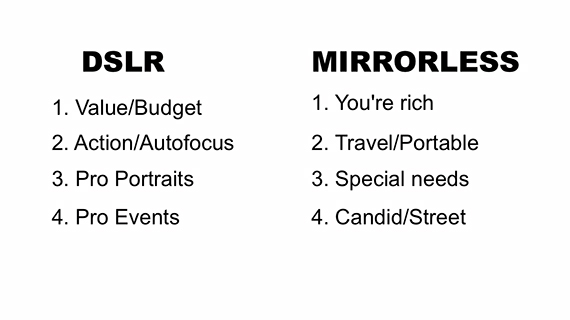If you’re in the market to buy a new camera, your first step will be deciding between a DSLR and a mirrorless camera. The choice is a common problem photographers struggle with. While both types of cameras have the ability to capture great photos, each has its own list of advantages and disadvantages. Professional photographer Phil Steele summarizes the differences and how to choose what’s best for you in this helpful tutorial:
While there is no clear cut winner on which camera option is better, Steele advises camera users:
“Be skeptical of the advice of anyone who tells you there is a clear winner. Usually those people are rationalizing their investment in one system or the other, and so they turn a blind eye to the benefits of the other system.”
DSLR
There are three main advantages to using a DSLR (digital single lens reflex) camera:
- First and foremost is the value. DSLR cameras have been around longer. Therefore, they provide more bang for your buck and are the typical choice for photographers on a budget.
- Secondly, a DSLR camera provides fast and accurate autofocus. Currently, there is not a mirrorless camera that can match the speed of a DSLR’s autofocus, making it a great option for photographers who work with action or movement. This includes events, dancing, sports, or any other type of fast moving photography.
- Last but not least, the DSLR camera provides the intimidation factor. Typically professional photographers are expected to have a big camera, especially if they work with events, portraits, or weddings. Not only does it provide a more professional perception, but it can also grant you access to areas you may not otherwise be able to obtain.
The biggest disadvantages to DSLR cameras are weight, size, and the fact everyone knows when you’re taking a shot.
Mirrorless
The biggest advantage to mirrorless cameras is size. Since the mirror and prism assembly used to look through the lens are removed from within the camera, the components fit into a smaller package. As a result, as long as you don’t add any large and/or heavy lenses, a mirrorless camera is smaller, lighter, and more portable. Due to the size, the mirrorless camera is perfect for travel and capturing candid shots, making it a great option for both street and event photographers.
Unlike a DSLR camera, the mirrorless camera uses an electronic viewfinder (EVF) to show you the images. While this does allow you to view your exposure changes in real time and helps you see in darker settings, the EVF is made up of pixels. Therefore, the resolution will not be the same as looking at the real world, and many photographers also experience time lag.
Although light and portable, the downfall for mirrorless cameras is you tend to sacrifice features and quality. While you’re able to push up the features and quality with different accessories, that typically increases the weight to more than that of a DSLR camera.
Mirrorless cameras currently tend to cost more, as well.

DSLR vs. Mirrorless
In the end, it’s really about what you’re trying to accomplish with your camera. Although DSLRs provide plenty of lens and accessory options, they’re also more complex and tend to be drastically bulkier. While those looking for something more portable may find the mirrorless camera to be the best choice. Either way, as long as the camera allows you to capture the images you’re trying to take you can’t go wrong.
Like This Article?
Don't Miss The Next One!
Join over 100,000 photographers of all experience levels who receive our free photography tips and articles to stay current:






Claude – It isn’t that you become more professional just because you use a DSLR camera; it is more about what people expect. The average person expects a professional photographer to use a larger camera. While it in no way means the camera is better; those who are unfamiliar with cameras typically view it as ‘the larger the camera the better it is’ (whether or not the view is accurate).
Wendy – By no means are these all of the differences (pro & con) to using a DSLR or Mirrorless camera. The pros and cons I centered around were those used within the video. As you stated, Battery Usage is a major factor in the type of camera many photographers use; especially for photographers who (as you stated) have to sit and wait for their subject to appear.
You forgot battery usage. If you’re in the field waiting for some critter to get in just the right position, staring through an optical viewfinder isn’t wasting juice. Needing to keep turning the LCD screen on to see if the critter’s in frame is a good way to have the battery die just as you get the perfect composition.
Interesting article Chelsea.
But it is look like your cameras are DSLR!
Differences in both:
DSLR: – Value, you are rich, you are physically stronger, you think you look professionnel.
But for birds powerful lenses, DSLR is for you.
Mirorless: Not expensive (Leica the exceptions), Much great choice of superb lenses, camera are super fast with auto-focus, wedding, sports* no problems (More Pros are doing jobs with mirorless now) But for birds powerful lenses, DSLR is for you.
* Now in mirorless some have the +11fps with auto-focus (perfect for sports) with camera choices of Full Frame or APSC
Note: I was with Nikon FF before my switch to mirorless without une penny of regret.